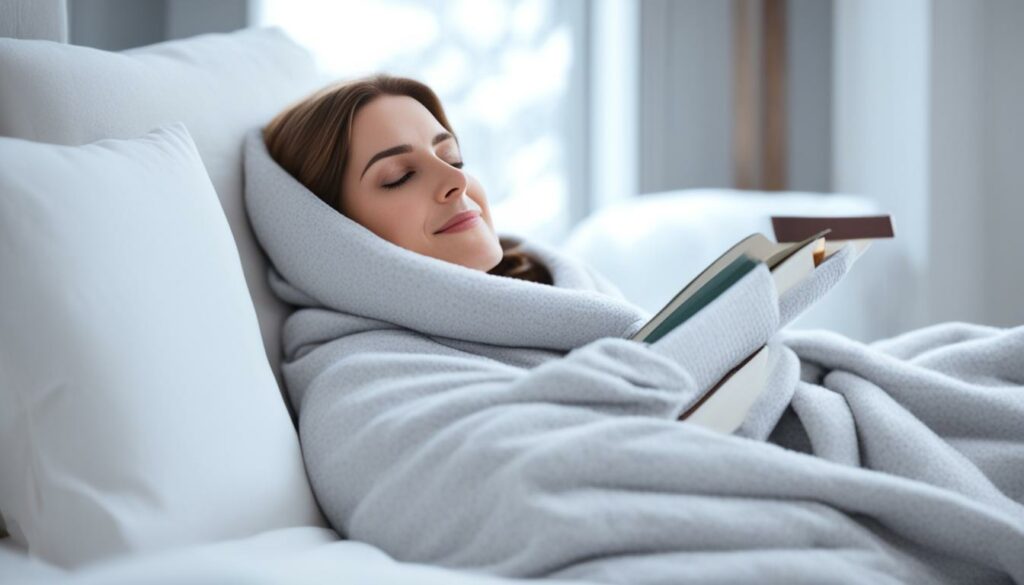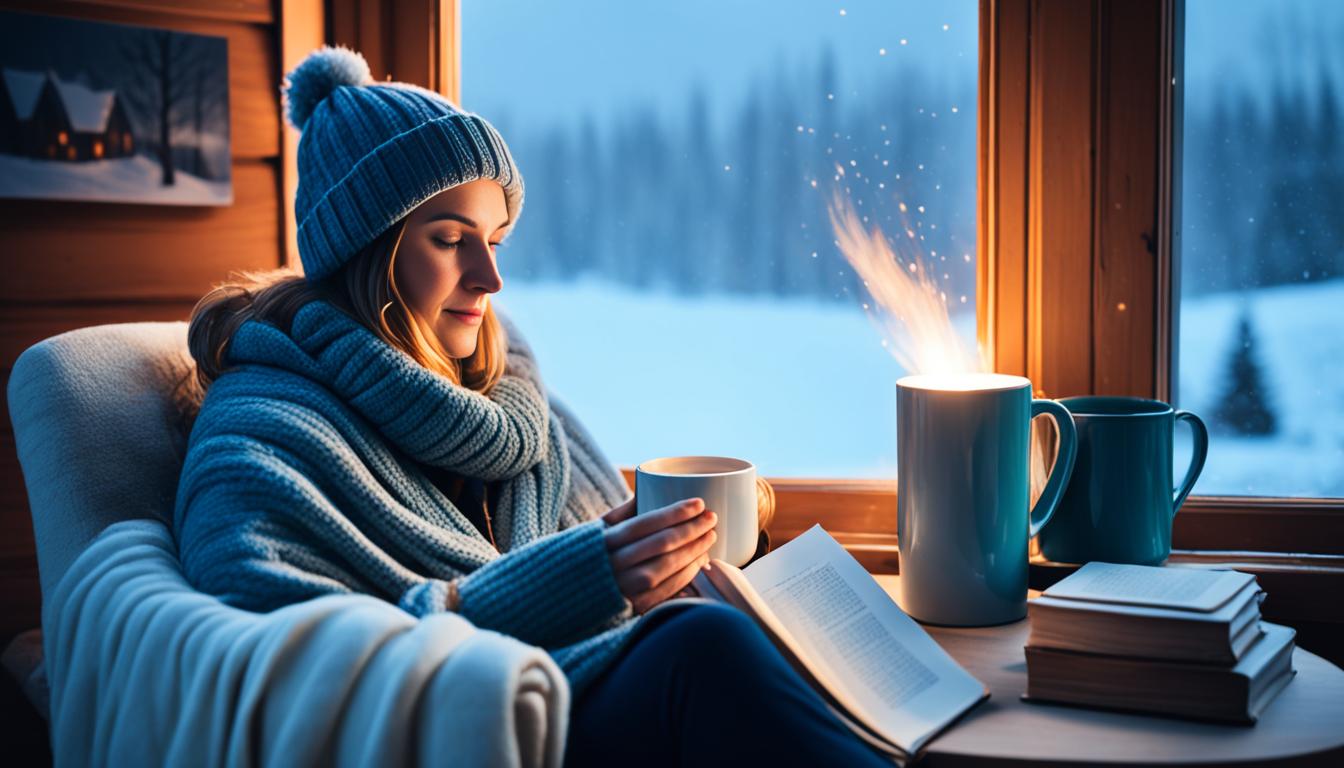When it gets cold, staying warm is key, especially if you’re off the grid or without a fire. Luckily, there are many ways to keep cozy without a fire. This guide will show you simple tips and tricks to stay warm.
Key Takeaways
- Wear layers that keep moisture away, insulate you, and protect you from the weather. This helps keep your body heat in.
- Use thermal blankets and hand/foot warmers for quick warmth without a fire.
- Stay active, drink plenty of water, and use appliances and hot water bottles to help keep warm.
- Make your living space warm by sealing it up and using safe portable heaters.
- Focus on keeping the heat in, not just making more heat, to stay warm without a fire.
Layer Up for Maximum Warmth
Staying warm without a fire can be tough, but layering is key. Start with a moisture-wicking base layer to keep your skin dry. Then, add insulating mid-layers like wool or fleece to keep warm.
Finish with a windproof and waterproof outer shell to protect you from the cold. This way, you stay warm and dry.
Don’t forget about your hands and head. Use a warm hat, thick winter accessories like gloves or mittens, and insulating socks for your feet. This keeps you warm from head to toe.

It’s important to balance breathability and insulation. Cotton absorbs moisture and makes you feel cold. Choose fabrics like merino wool or synthetic blends that wick away sweat.
With the right layers, you can adjust your clothes for different conditions. This keeps your body temperature steady all day.
“Layering is the secret to staying warm without a fire. It’s all about building that personal microclimate to keep the chill at bay.” – Outdoor Enthusiast
Embrace Thermal Blankets and Hand Warmers
When it gets cold and there’s no fireplace, thermal blankets can save the day. They reflect your body heat back to you, keeping you warm. Hand and foot warmers are great for extra warmth when you need it.
Harnessing the Power of Thermal Blankets
Thermal blankets are thin and metallic. They reflect up to 90% of your body heat back to you. They’re light and easy to carry, perfect for your backpack or car.
Just open the blanket and wrap it around you for warmth. These blankets can also be used as emergency shelters or ground pads. They’re very versatile.
Disposable Hand and Foot Warmers
- Disposable hand and foot warmers keep your hands and feet warm.
- They’re small packs that react with air to make heat. Inside, there’s iron, salt, and water.
- Just tear off the backing and put them in your gloves or pockets to activate them.
- They can keep you warm for up to 10 hours. Great for outdoor activities or when you’re feeling cold at home.
Thermal blankets and hand warmers are great for camping, hiking, or staying warm at home. They’re simple but effective ways to beat the cold. Use them to stay cozy without a big fire.

| Product | Average Temperature | Duration | Placement |
|---|---|---|---|
| Thermal Blanket | Reflects up to 90% of body heat | Unlimited (as long as blanket is used) | Wrapped around body |
| Hand Warmer | Up to 135°F (57°C) | Up to 10 hours | Placed in gloves, pockets, or boots |
| Foot Warmer | Up to 135°F (57°C) | Up to 10 hours | Placed in socks or boots |
How to Stay Warm Without a Fire
In cold places, being without a warm fire can feel scary. But, there are ways to stay warm without a fire. We’ll look at insulation and heat retention to help you stay cozy.
Insulate, Insulate, Insulate
Insulation is key to keeping warm without a fire. Make sure your home is well-insulated by sealing drafts. Use materials like fiberglass or spray foam for insulation.
Also, use curtains, rugs, and blankets to keep heat in your home.
Harness the Power of Layering
Layering is a great way to stay warm. Start with moisture-wicking fabrics for your base layer. Then, add insulating layers like fleece or down jackets.
Finish with a weatherproof outer layer to protect you from the wind and rain.
| Insulation Material | R-Value (Thermal Resistance) | Advantages |
|---|---|---|
| Fiberglass | R-3.2 to R-4.3 per inch | Affordable, widely available, good thermal performance |
| Cellulose | R-3.7 to R-4 per inch | Made from recycled materials, effective in reducing air leaks |
| Spray Foam | R-5 to R-7 per inch | Excellent insulating properties, can seal hard-to-reach areas |
Using these tips, you can stay warm without a fire. A bit of planning and creativity can help you beat the cold.
Create a Warm Microclimate
Staying warm when it’s cold doesn’t just mean having a big fire. You can make your area warmer by creating a warm microclimate. Using windbreaks, insulating your area, and heat-trapping methods can make your space cozy and safe.
Using windbreaks is a great way to keep warm. Put up walls, fences, or lots of plants to block cold air. This makes a safe spot in your living area.
It’s also key to make your living space more insulating. Seal up drafts and add insulation to walls and ceilings. Heavy curtains or rugs can also help keep the heat in.
Using heat-trapping methods helps too. Reflective panels or insulating materials on windows keep heat from leaving. This makes your space stay warm.
By using these ideas, you can make a warm, safe spot even when it’s cold. Try warm microclimate, insulating living space, windbreaks, and heat-trapping to stay cozy without a fire.
Stay Active and Hydrated
Keeping your body active and well-hydrated helps you stay warm without a fire. Light exercise or movement keeps your blood flowing and keeps you warm. Drinking enough water helps your body make heat.
When it gets cold, keep your body moving. Simple things like stretching or walking can make you warm. This is great if you’re inside and no fire or heater.
Drinking lots of water is also key for staying warm. Water, broths, or warm drinks help your body work better and keep heat. Don’t drink things like alcohol, as they can make you colder.
“Staying active and hydrated is key to keeping warm without a fire. The body’s natural processes work best when they’re fueled and in motion.”
Doing light exercise and drinking proper hydration keeps you warm naturally. Listen to your body and adjust how much you move and drink to stay comfy.
Harness Heat from Appliances and Hot Water Bottles
When it gets cold, think outside the box for heat. Don’t just layer up and insulate. Use everyday items to stay warm and comfy.
Utilize Oven Heat
After cooking, keep the oven door open. This lets the oven heat spread and warm your space. It’s a quick way to add appliance heat without turning up the heat.
Embrace the Warmth of Hot Water Bottles
For fast, localized warmth, try a hot water bottle. Fill it with hot water and hold it or put it under a blanket. The hot water bottle heat feels great, especially for your feet and hands.
| Appliance | Warmth Benefit |
|---|---|
| Oven | Releases residual oven heat to warm the room |
| Hot Water Bottle | Provides localized warmth when held close to the body |
Using appliances and items like hot water bottles keeps you warm. You don’t need a fire or central heating. These tips use what you already have at home.
Seal and Insulate Your Living Space
Make sure your living space is well sealed and insulated. This helps keep the heat in and out. Check for cracks or drafts around windows, doors, and openings. Sealing these spots will weatherproof your home and keep warm air inside.
Adding more insulation in your living area is key for staying warm and saving energy. Use materials like fiberglass or cellulose to trap warmth and stop heat from escaping. This makes your home cozy and keeps your energy bills low.
| Sealing Drafts | Insulating Living Area |
|---|---|
|
|
By sealing drafts and improving insulation, you boost your living space’s thermal efficiency. This keeps you warm and cozy without needing a fire or high heating costs.
“Proper sealing and insulation can reduce heat loss by up to 30%, leading to substantial energy savings and a more comfortable living environment.”
Utilize Portable Heaters Safely
When it gets cold, portable electric heaters can help keep you warm. But, you must use them safely to protect yourself and your family.
Space heaters are great for warming up a single room. But, they have risks. Always keep the portable heater away from things that can catch fire, like curtains or bedding. Also, choose ones with features that turn them off if they fall over or get too hot.
Space heaters don’t make carbon monoxide, but some others do. Make sure your portable heater is in a place with good air flow. Never use it in a closed room or while you’re asleep.
- Choose a portable heater with automatic shut-off features for added safety.
- Position the space heater at least 3 feet away from flammable materials.
- Ensure proper ventilation when using any type of heating device to avoid carbon monoxide buildup.
- Never leave a portable heater unattended or run it overnight.
Follow these easy fire safety tips to stay warm and safe with a portable heater. Be careful and smart this winter.
Conclusion
Follow the tips in this article to stay warm in cold weather without a fire. Wear moisture-wicking base layers, insulating mid-layers, and windproof outer shells. Use thermal accessories like blankets and hand warmers to beat the cold.
Stay active and drink plenty of water to keep warm. Use heat from appliances and hot water bottles. Portable heaters can also help, but use them safely.
Make your home warm by sealing and insulating it. This helps keep the heat in.
Whether you’re outside or inside, these tips will keep you warm. You can enjoy winter without a fire. Stay informed and use these strategies to enjoy the season.
